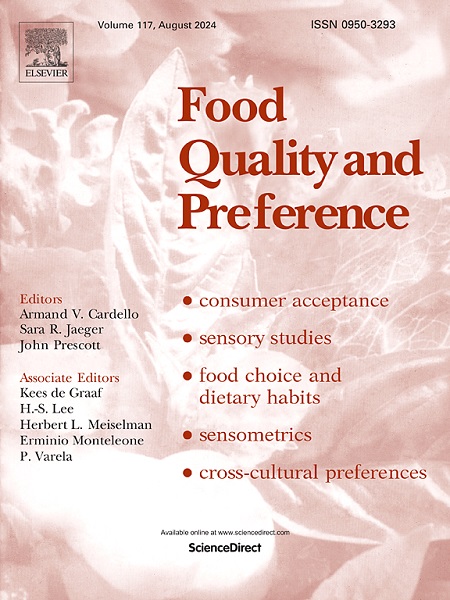Increasing the spiciness of a lunch meal influences oral processing behaviors and decreases food and energy intake
IF 4.9
1区 农林科学
Q1 FOOD SCIENCE & TECHNOLOGY
引用次数: 0
Abstract
Recent evidence suggests increasing oral burn by adding chilies to food modifies oral processing behaviors like eating rate, but how these modifications affect food intake remains unclear. In 3 crossover experiments, adults ate a 650 g lunch of beef chili [experiment 1; n = 52] or chicken tikka masala [experiment 2a; n = 44, and 2b; n = 34] twice in the laboratory while being video-recorded. We tested how adding chiles to a meal influenced (a) food intake and (b) oral processing. A consistent weight of paprika was added, but the ratio of hot-to-sweet paprika was varied, to make spicy (100 % hot paprika) and mild (75–100 % sweet paprika) versions of meals. Meal duration was extracted from videos to calculate eating rate (g/min). Participants rated liking and spiciness on a VAS before and after consumption. In Experiment 1, participants ate more slowly (p = 0.04), consuming 11 % less (46 ± 17 g) spicy chili relative to mild chili (p = 0.009). While initial ratings of spiciness differed (p < 0.0001), liking did not (p = 0.88). In Experiment 2a, spiciness ratings did not differ between conditions (p = 0.22), and intake did not differ (p = 0.36). Experiment 2b increased the total amount of paprika in the tikka, leading to significant differences in spiciness between conditions (p < 0.001), without affecting liking (p = 0.19). As with Experiment 1, this increase in spiciness resulted in an 18 % reduction in food intake and a 17 % reduction eating rate (both p's < 0.005). Overall, these experiments identify a non-textural manipulation that can be used to slow eating rate and reduce ad libitum intake without adversely impacting food pleasure.
增加午餐的辣度会影响口腔加工行为,减少食物和能量的摄入
最近的证据表明,在食物中添加辣椒会增加口腔灼烧感,从而改变进食速度等口腔加工行为,但这些改变如何影响食物摄入量仍不清楚。在3个交叉实验中,成年人午餐吃650克牛肉辣椒[实验1;N = 52]或鸡tikka masala[实验2a;N = 44, 2b;N = 34]在实验室进行了两次,同时进行了录像。我们测试了在一餐中添加辣椒是如何影响(a)食物摄入和(b)口腔加工的。加入辣椒粉的重量是一致的,但辣椒粉与甜辣椒粉的比例是不同的,以制作辛辣(100%辣辣椒粉)和温和(75 - 100%甜辣椒粉)的食物。从视频中提取进食时间,计算进食率(g/min)。参与者在食用前和食用后分别对喜欢度和辣度进行VAS评分。在实验1中,参与者吃得更慢(p = 0.04),与轻度辣椒相比,他们吃的辣味辣椒少11%(46±17克)(p = 0.009)。虽然最初的辣度评级不同(p <;0.0001),喜欢度没有(p = 0.88)。在实验2a中,辣度评分在不同条件下没有差异(p = 0.22),摄入量也没有差异(p = 0.36)。实验2b增加了tikka中辣椒粉的总量,导致不同条件下辣椒的辣度差异显著(p <;0.001),不影响喜好(p = 0.19)。与实验1一样,辣度的增加导致食物摄入量减少18%,进食率减少17% (p's <;0.005)。总的来说,这些实验确定了一种非纹理操作,可以用来减缓进食速度和减少随意摄入,而不会对食物的愉悦感产生不利影响。
本文章由计算机程序翻译,如有差异,请以英文原文为准。
求助全文
约1分钟内获得全文
求助全文
来源期刊

Food Quality and Preference
工程技术-食品科技
CiteScore
10.40
自引率
15.10%
发文量
263
审稿时长
38 days
期刊介绍:
Food Quality and Preference is a journal devoted to sensory, consumer and behavioural research in food and non-food products. It publishes original research, critical reviews, and short communications in sensory and consumer science, and sensometrics. In addition, the journal publishes special invited issues on important timely topics and from relevant conferences. These are aimed at bridging the gap between research and application, bringing together authors and readers in consumer and market research, sensory science, sensometrics and sensory evaluation, nutrition and food choice, as well as food research, product development and sensory quality assurance. Submissions to Food Quality and Preference are limited to papers that include some form of human measurement; papers that are limited to physical/chemical measures or the routine application of sensory, consumer or econometric analysis will not be considered unless they specifically make a novel scientific contribution in line with the journal''s coverage as outlined below.
 求助内容:
求助内容: 应助结果提醒方式:
应助结果提醒方式:


